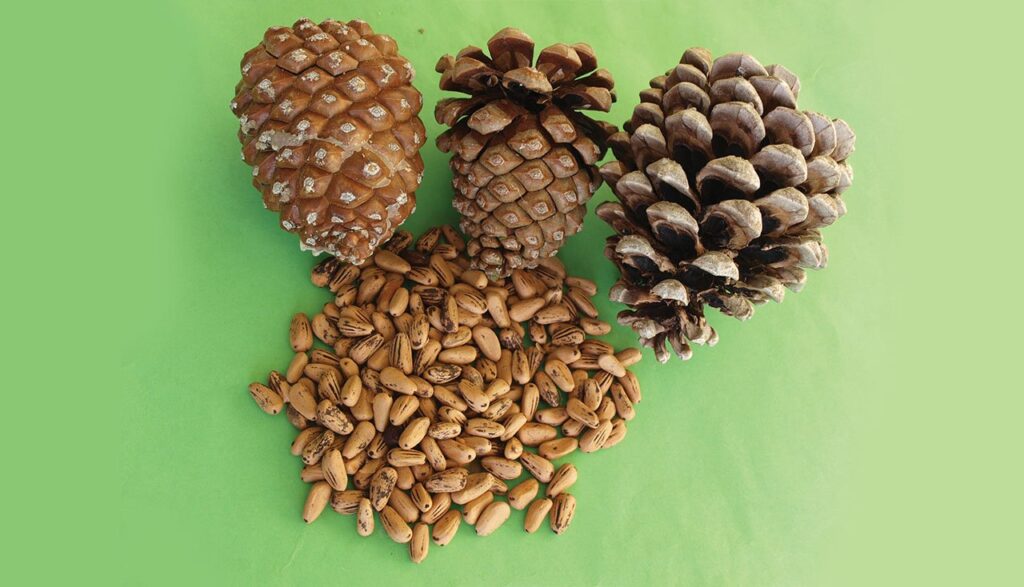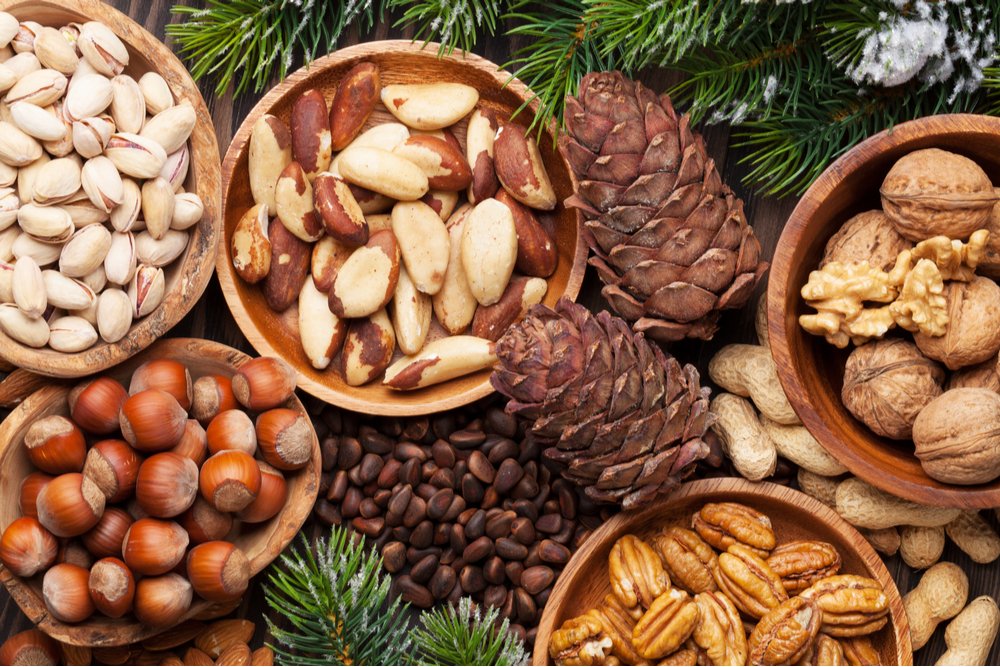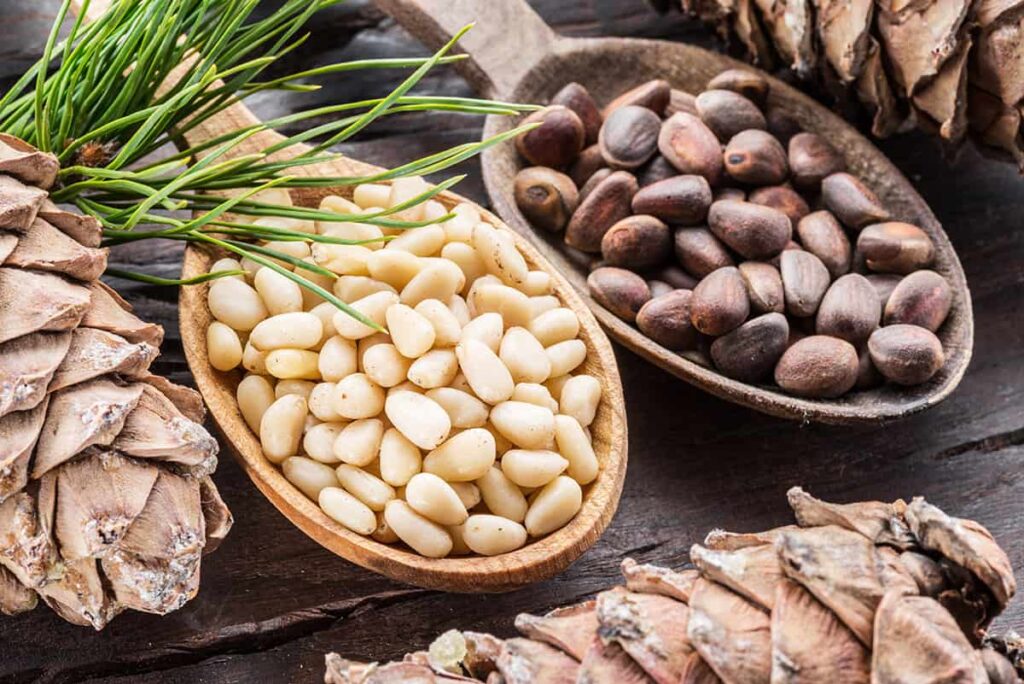Pine nuts grow in forests in their native countries of China, Russia, North Korea and Pakistan, not on farms.
Only 29 species provide edible nuts, while 20 are traded locally or internationally owing to their seed size is large enough to be worth harvesting. All pine trees produce nuts which you can eat. However, some species have much smaller nuts.
It can take up to 25 years for pine trees to start producing edible pine nuts and significantly longer for production to reach its peak. Pine nuts then need to be extracted as seeds, and the second shells must be removed before they’re ready to eat.

Pine nuts have a soft, nutty flavour with an undercurrent of sweetness, similar to cashews. A bitter taste can also be a sign that the natural oils in pine nuts have turned rancid, which happens if they’re left in the pantry too long after opening. Store pine nuts in the freezer to prevent extending their shelf life.
Pine nuts may be eaten raw but are usually roasted or toasted. As with most nuts, toasting brings out more flavour. Heating nuts will intensify the flavour of the nut by warming the naturally occurring nut oils. You can toast the nuts in the skillet, oven, or even microwave.
The buttery flavour and softly crunchy texture of pine nuts make them perfect in baked sweets, such as cookies, rolls, and cakes.
They can also be a flavour chameleon, the main ingredient in desserts like tarts, cookies, and brittles as well as savoury dishes, too. One of the best ways to use pine nuts is in the starter course, by mixing them into dips for crudité, frying into finger foods, or pairing with beef in empanada fillings.
10 Substitutes for Pine Nuts
What happens when you do not have at home pine nuts and you were going to make a delicious pesto? Or the nearest shop did not have it at that time? There are nut and non-nut substitutes.
Replace with nuts such as:
- Cashews (chopped and toasted)
Cashews have a lightly sweet flavour and soft texture that mimics pine nuts rather well. Chop them down into roughly the size of pine nuts, about 1/2-inch long pieces. Or, Toast the cashews in a dry pan for 3 to 5 minutes over medium heat until they are fragrant and lightly browned. Toasting the nuts gets an even more similar flavour to the nuttiness of pine nuts. - Almonds ( raw, soaked, pilled)
Almonds are very versatile. They have an almost identical texture, so they are a fantastic substitute for pine nuts. They work well in sweet and savoury applications. What’s more, almonds are inexpensive. Soak the almonds in water for 6 hours and peel them. This way, almonds will resemble pine nuts even more.
- Pistachios
Although a little different than pine nuts, they still make an excellent substitute in pasta, pesto, and salads. When baking them, use unsalted pistachios or you may take the recipe out of balance with saltiness. In pesto, the green-coloured nut goes well with basil and its slightly sweet flavour is a pleasant addition to the sauce. - Peanuts (unsalted or honey-roasted)
Peanuts are looked at as the cheapest substitute for pine nuts. Use unsalted or honey-roasted peanuts to add a pleasurable flavour to your dish. While we wouldn’t recommend peanuts for use in pesto, they are tasty added to cookies and provide a delicious crunchy texture to stir-fries. - Walnuts
Walnuts taste bitter compared to pine nuts. Regarding substitution for pine nuts, walnuts are a viable alternative in salads and bread. If you would like to use them as a substitute for pine nuts in a pesto recipe, then soak them in water first and peel them. Removing the skin will help if you are making this walnut and watercress pesto sauce. - Macadamia nuts
Though they are not really cheaper than pine nuts, macadamia nuts are a great substitute in terms of texture and taste. They have a creamier, richer, and stronger flavour that works excellently in desserts and sweets. Use salted macadamia nuts for savoury recipes such as salads or pestos. Go for unsalted macadamias for desserts. - Pecans
Pecans have a unique flavour that is sweet and buttery, but you could use them as a backup if you’re in a pinch. They are higher in oil content, which is what makes them so tasty, but we suggest reducing the olive oil a little if you’re making pesto. Pecans are perfect for roasting with honey and crushing before adding to homemade ice cream. Baked goods like cakes, cupcakes, and bread that call for pine nuts will all benefit from pecans.

Replace with non-nuts:
- Sunflower seeds
Sunflower seeds are excellent for adding crunch to salads and they also make a nutritious addition to bread. They come from dried sunflowers and add a mild, nutty flavour to food. We wouldn’t recommend using these seeds in pesto as they impart a grey colour into the sauce which may not look appealing.
- Sesame seeds
These are not the best substitute for pine nuts because sesame seeds have a completely different texture. Use them only as a flavour enhancer in salads or sauces.
- Pumpkin seeds
Lots of recipes are available that use pumpkin seeds or pepitas instead of pine nuts. A great source of proteins and minerals, pumpkin seeds are the right choice if a person suffers from nut allergies. There is no need to stop making your most-loved recipes because it contains pine nuts. You can still devour your favourite dish by using a substitute for pine nuts.
Healthy Benefits of Pine Nut
Pine nuts are a source of omega-3s, containing 31.4 mg per ounce (28 grams). According to the National Institutes of Health, the recommended daily intake for adults is 1.1 grams for females and 1.6 grams for males.
Pine nuts are healthy when added to your diet in moderation.
Pine nuts can increase your energy levels due to their protein, iron, and magnesium. The antioxidant power of vitamin E contained in them may help keep your skin healthy and young in appearance.
These tiny seeds pack a variety of nutrients essential to your health, including vitamins, minerals, and heart-healthy fats. While they are high in fats, they have minimal saturated fat. The balance of healthy fats, protein, and fibre in a serving of pine nuts can help keep blood sugar levels stable, help with diabetes management, and support your heart health.
- Better heart health – Pine nut consumption is connected to lower levels of ‘bad’ LDL cholesterol in the blood and lower blood pressure, enhancing overall heart health.
- Lower body mass index – Eating tree nuts, including pine nuts, is linked to a lower body mass index. Incorporating pine nuts into a healthy and balanced diet may help you achieve any weight loss goals.
- A healthier brain function – Nuts supply the brain with essential nutrients. The result is that pine nuts can help reduce the risk of illnesses associated with cognitive decline.
- May help maintain a healthy weight – Pine nuts contain a combination of protein, fibre, and healthy fats, all of which help keep you feeling fuller longer. Even though nuts are a high-calorie food, they don’t contribute to weight gain, and they help you feel more satisfied.
Famous food made or complemented with pine nuts:
Pesto Sauce
Pignoli Cookies
Arugula Pine Nut Salad
Check out more recipes: gypsyplate.com

